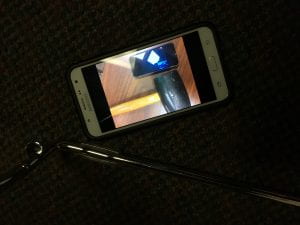Photograph (Score)
https://experimentalgamedesign.sites.northeastern.edu/files/2017/09/Photograph.pdf
Inspiration
My piece of score was inspired by Yoko Ono’s utilization of the environment and audience’s interpretation. In her scores, they can be performed in pretty much any kind of environment, which makes each happening that the audience participate in unique and different from others. That’s what I really liked about her scores, because every time her scores are performed, a different result is produced. A different environment takes part each time. The little details that we don’t often notice in our everyday environment may also be involved in her scores. With that said, my score works by having a person photograph something of “significance” in their environment. After that, find another person to photograph something of “significance” in the same environment, but this time with first person’s picture in the frame. Repeat this process until there is no significance left in the room. So my score is inspired by the environment aspect of Yoko Ono’s work. I hope that through this score, people may notice about and pay attention more to the little details in their environment, and perhaps become more aware that even the smallest detail can be of “significance”, that there is more to one’s everyday life / routine. On the other hand, I also wanted my work to be very open to interpretation. For Yoko Ono, the steps in her scores are very broad, vague and open ended. Anyone could interpret her scores very different ways and that is what I like so much about her work. Different interpretations, ideas, and thinking could come into play by having the audience to participate. With that said, I think it’s that open-ended aspect that makes the performances of her scores much more interesting and fun, because every performance would be different. Overall, I was very inspired by how Ono doesn’t follow the rules, and how she has kind of a laissez faire way of doing things. I hope that I could implement such ideas into my score too. Other works that have inspired this piece would be the movie Inception. I really liked the idea of layers and how each layer of the dream state becomes deeper in the movie. However for this case, each layer of picture is meaningful in its own way. Celia have mentioned to me that my score reminded her of the TV Buddha by Nam June Paik, and now that I’m thinking about it, I would certainly agree that that piece has a similar concept to mine, which I admire. I like how that piece has like an infinite recurring action similar to my score. My score has that degree of infinity aspect to it too, because people can take however many pictures they want.
Documentation
 First picture taken in the score today
First picture taken in the score today
 The final picture of the score from today’s class
The final picture of the score from today’s class
After performing the score today in class, there are some things to consider about next time this score is done. The camera quality of the phone plays a big role, because lower quality cameras may make certain pictures harder to see, which thus affects all layers of photos in the score. Another thing is the distance between the phone with the picture and the phone with the camera. In previous iterations, I didn’t explicitly mention distance that the phone should be inside the camera frame. The further the distance may make it difficult to view the picture so I changed that to, the phone must be placed in either one of the four corners of the camera frame. One last thing that I noticed when performing my score in class today is the lighting. It is important to keep in mind the lighting of the shot, and make sure that it doesn’t affect the overall lighting of all previous pictures. Such things are important to consider about when performing the score because one mistake could potentially affect all previous layers of pictures.
Iterations
- My idea started off first with Snapchat, and how you can add friends into a “group / shared” story function. I wanted to do this score where people just basically take and upload snaps of something of “great significance” in their environments to the group story. However, I didn’t think this would be unique as others may view that as just a typical Snapchat story.
- Andre made an interesting suggestion in which instead of doing a picture within a picture, layer by layer, the audience would get their phones and each take a picture or something significant, until there is no one left, and combine all those phones together in one last photo frame, with one last significant part of the environment in the middle. So instead of having one phone in each photo every time, this would be having all the phones involved in one picture.
- Finally, another iteration that could be tested in the future would be to just be consistent with 2 phones. 2 phones with good quality cameras and see if that could overcome the quality issue.
Overall, the score went very smoothly. People brought in different ideas as to what significance was to them in the classroom environment, and people seemed to enjoy taking part in the score. The final picture was not very clear and hard to see because of the phone camera quality. However, next time, we could take the suggested iterations above into consideration to hopefully produce better and more interesting results!
